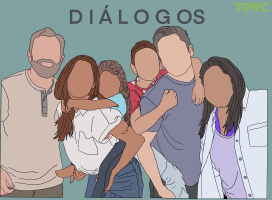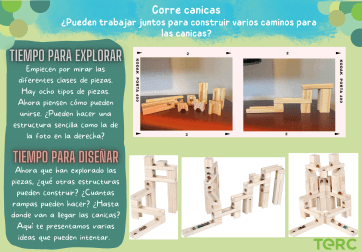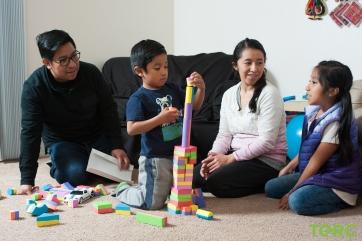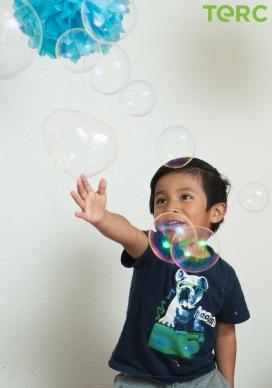Equity Project Spotlight: Diálogos: Harnessing Latinx Community Cultural Wealth to Support Executive Function in Early Childhood through Family Engineering Experiences
Smirla Ramos-Montanez, TERC, shares more about the Diálogos: Harnessing Latinx Community Cultural Wealth to Support Executive Function in Early Childhood through Family Engineering Experiences (NSF Award #2115463).
"If a community partner is telling you something is not working, and you're stuck because this is the way that you conduct research, introspection needs to occur. You have to ask what you can change or whether there can be a compromise."

How would you describe this project and the big ideas of what you would like to see come out of it?
The project is an exploratory project designed to engage parents as research partners in exploring the ways we can leverage informal family engineering activities to support the development of executive function skills for preschool-age children from Latinx families. As an exploratory project, we are trying different ways that center equity and help us work collaboratively with families. We engage in conversations and activities that allow us to explore and highlight the strengths, knowledge, and assets of the Latinx community to reimagine a more equitable vision of STEM learning.

What inspired you to start this project?
The project has been a natural progression from the NSF-funded AISL project Head Start on Engineering (#1906409). In that project we’ve been working closely with families for the last 10 years to learn about their experience with the program, especially with home-based engineering activities that are part of the program. We work closely with families to understand their perspectives around engineering, how they were using the engineering activities, and in which ways the activities were supporting them to meet their goals.
Connections between engineering and executive function
Many caregivers shared how the activities went beyond engineering engagement. They talked about handling challenging emotions that come from having a family play with an activity, especially with their young children. These conversations included how they handled their children’s frustration or how they helped their children handle that frustration to promote persistence. Families also talked about using these activities with multiple children and how they could support and build stronger relationships between siblings. At the same time we were also hearing from Head Start teachers about how the activities could connect to their classroom goals around social-emotional development.
We saw that these activities are engineering-related, and families are practicing engineering, but it's also helping them do other things. Families were naturally adapting and bringing up a connection with executive functioning that they thought was important. We wanted to continue to explore this connection.
Engaging parents and conversation in asset-based narratives
We paid attention to this connection between engineering and executive function and began to explore the literature as these conversations were happening. We noticed that a lot of the research around executive function with families and children, especially from marginalized groups, perpetuated deficit-based narratives. There are a lot of pervasive deficit-based ideas around family learning and parent and family engagement that we wanted to fight against and show how parents are deeply involved and engaged with their children’s learning.
This project is an opportunity to work closely with our Latinx community and highlight their strengths and knowledge, and explore what aspects of executive function and engineering were important to them to change these deficit-based narratives to more asset-based ones. We wanted to see how equity could be centered in the work.

How did you conduct outreach with the communities you worked with?
We have been working to cultivate partnerships with two primary community organizations that serve families from all backgrounds in the Portland metro area: Mount Hood Community College Head Start and Metropolitan Family Service. We've been lucky enough that we've been cultivating those partnerships across a variety of projects and are committed to working with them in the long term. That is really important because we see the power of committing and cultivating long-term relationships with partners across time. We try to be intentional to find opportunities that can support a partnership. I think we share similar goals, and we want to work together to support the families.
The leadership structure always includes members from our community partners. These members are an integral part of the project. They're working closely with us to support all levels of the project, like the development, the family recruitment and the project activities. That’s been critical because they really help us with the outreach and talking to families and also understanding the goals families have and the kinds of opportunities that could be a good match for those families to participate in.
How did you build trust with the community members that you worked with?
"We were honest with families that we're doing this together and that we wanted to do research in a different way. All of us had a common goal to take this information and create more programs and opportunities for families that could help them meet their goals."
Our outreach is mostly driven by our community partners. That’s important to us. It contributes so much to the trust that has to be in place, and that has to be cultivated in order for the project to be successful.
We’re lucky because we've been able to cultivate those partnerships with our community organizations. It's nice to start with that foundation. There is already some built-in trust from families because they are part of the program set, and they've been working with our community partners for a long time. But I also feel a lot of responsibility: there's this built-in trust, and we have to live up to and continue to support that across the project and beyond.
One of the biggest aspects when building and continuing to support that trust has been ongoing communication and intentionality about relationship building. For example, this project is based on a series of dialogue groups. We have two dialogue groups going on with our Head Start partner and with Metropolitan Family Service.

We had four goals when designing what those dialogue groups would look like. We knew that those goals were equally important, and that they might look different across meetings, but we always had to hit those four goals. One of those was building community, the other one was finding opportunities to explore and highlight the assets of our Latinx community, and then the other two goals were to find the opportunities to engage in conversations and spark those connections between engineering and executive function in a general and more focused way. The dialogues started with broader and then moved to narrower and deliberate conversations, but we always had to make the space to be able to build that community and create that trust.
We met virtually with a subset of families ten times across a year. We talked to them about what their own goals were and what mattered to them and tried to create a space so their goals could be met. All of us are learning from each other. Nobody's an expert. This was the good thing about this being an exploratory project: we're exploring this connection for the very first time, and while we knew some of the connections, we didn't know many of them. We were honest with families that we're doing this together and that we wanted to do research in a different way. All of us had a common goal to take this information and create more programs and opportunities for families that could help them meet their goals.
Did you get feedback from participants and community members? How did you incorporate this feedback into the project?
"The research that we've been doing has allowed us to have more of that ongoing feedback loop across rather than just waiting at specific moments in the project to gather it."
Feedback is part of the process of creating trust. Families should have a space to provide their thoughts and ideas, and they're able to see how those thoughts and ideas are being implemented. It's critical. We try to create those opportunities and ask for ongoing feedback in our dialogue groups.
For example, we tried to use language that families use to talk about engineering and executive function. When our dialogue group started, families were talking about their goals and expressed that they wanted to help their children become flexible problem solvers. We shared that this goal aligned with what we wanted to do since it allows us to explore both engineering and executive function. So we then use that language they used to explore and ask, “Well, what does it mean to you for your kids to be flexible problem solvers? What kinds of resources do you think can support that? Or what kind of knowledge or ideas do you want to have that can help you meet this particular goal?”
We listened to families and based on what they shared we prepared sets of materials, and engineering activities that they could take and they could test at home as a family. In the next dialogue group, we would incorporate an opportunity for them to share what their experience was like, how the materials worked, what kinds of challenges and opportunities came from that experience. Then we would ask them how they would improve this for other families, what they would do if they did the activities differently.
One critical example that came up was how many of the families talked about trying to do these activities with multiple children. Sibling relationships are such a unique context for practicing EF and engineering-related skills and this emerged naturally in the group. Parents talked about collaboration and they asked if we could share anything about how to support sibling relationships using the materials and activities. Based on that feedback we created a handout with different kinds of facilitation ideas for parents. They then tested out the activity and the ideas in the handout and at the next meeting we asked how it worked and if they wanted to make any changes. It’s a constant feedback loop and that was helpful for us. I know this can be more constrained with other projects, but the research that we've been doing has allowed us to have more of that ongoing feedback loop across rather than just waiting at specific moments in the project to gather it.

What recommendations do you have for those who want to do similar work and collaborate with similar audiences?
Building strong partnerships
It's important to think about focusing on building a strong partnership. That’s been a topic for discussion for many years, especially in the AISL community, and it's something that takes a lot of time and work. If you're working with a community partner, be committed and intentional about building that strong partnership and identifying common goals.
I think being willing to hear and be responsive and flexible to their needs is critical. That's something that we learned, because this project began in the middle of the pandemic. You have to understand the needs your community partner has and how you can be flexible and responsive to those.
Being open to constructive criticism and willing to change is important. If a community partner is telling you something is not working, and you're stuck because this is the way that you conduct research, introspection needs to occur. You have to ask what you can change or whether there can be a compromise. Sometimes when we work on proposals time can be a big constraint and that can create uncertainty but I would say just make sure that you're not cutting away from the time and the effort that goes into building and cultivating the partnership just to, like, you know, be done with your proposal and submit it. I think all the projects really would benefit from those strong partnerships. So it's time that's well spent.
Learning with the community
I think the second one is being willing and open to learn with the community you're trying to serve, not learning about the community you're trying to serve, but be ready to learn with them. Research projects and ideas usually tend to emerge from the researcher's perspective and are based on their own interest or the problems that they believe need to be fixed. With this project, it’s been wonderful to spend time with the community that we are trying to serve and learn about what's important to them, what they care about, and what are their needs and values. Working to craft something that can meet those needs and values requires me to let go of some of the control that I feel l I would want to have in my researcher role.
I am so thankful for this project and have learned so much about centering equity in research. I am excited about continuing to serve our Latinx communities and apply what we have learned across more projects.